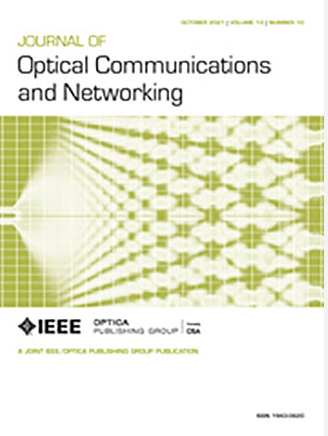基于环形嵌入神经元多维非均匀分割置乱的10.24 Tb/s无源光网络物理层安全
IF 4.3
2区 计算机科学
Q1 COMPUTER SCIENCE, HARDWARE & ARCHITECTURE
引用次数: 0
摘要
针对无源光网络中数据传输的安全性问题,提出了一种基于环形嵌入神经元的多维非均匀分割置乱加密方案。该方案可以有效地保护大容量超高速pon的数据不受传输物理层的影响。利用两个神经元混沌系统,通过循环嵌入的方法生成混沌序列,对原始数据进行加密。所得到的混沌序列分别用于位非均匀切割、位块非均匀切割、位块置换和I/Q数据非均匀切割和置换。与传统pon中的加密数据相比,该方案能够适应任意正交调幅。同时,该方案可以增强混沌非线性动力性能,减轻混沌局部振动的非线性退化。该方案在一个四芯光纤波分复用双偏振相干PON中得到了验证。实验采用10gbaud 256QAM信号,传输距离为115 km,传输速度为10.24 Tb/s。所提出的加密方案的误码率可以满足${2}\次{{10}^{-{2}}}$ 20%的软决策前向纠错,最大灵敏度可达E-18。键空间已达到${{10}^{154}}$。结果表明,该方案能够兼容超高速大容量空分复用相干pon,并能对物理层传输的数据进行加密和保护,在未来的相干pon中具有很大的潜力。本文章由计算机程序翻译,如有差异,请以英文原文为准。
10.24 Tb/s passive optical network physical layer security based on multi-dimensional non-uniform segmentation scrambling with annular embedded neurons
Aiming at the security of data transmission in passive optical networks (PONs), this paper proposes a multi-dimensional non-uniform segmentation scrambling encryption scheme based on annular embedded neurons. This scheme can effectively protect the data of large-capacity and ultra-high-speed PONs from the transmission physical layer. Two neuronal chaotic systems are used to generate chaotic sequences by means of cyclic embedding to encrypt the original data. The resulting chaotic sequences are used for bit non-uniform cutting, bit block non-uniform cutting, bit block permutation, and I/Q data non-uniform cutting and permutation, respectively. Compared with encrypted data in traditional PONs, the proposed scheme can adapt to arbitrary quadrature amplitude modulation. At the same time, the scheme can enhance the chaotic non-linear dynamic behavior and alleviate the non-linear degradation of chaotic local vibration. The proposed scheme is demonstrated and verified in a wavelength division multiplexing dual-polarization coherent PON with 4-core fiber. The experiment uses 10 GBaud 256QAM signal to achieve a transmission distance of 115 km and a speed of 10.24 Tb/s. The bit error rate of the proposed encryption scheme can meet the 20% soft decision-forward-error-correction at ${2} \times {{10}^{- {2}}}$ , and the maximum sensitivity can reach E-18. The key space reached ${{10}^{154}}$ . The results show that this scheme can be compatible with ultra-high-speed and large-capacity space-division multiplexing coherent PONs and can encrypt and protect the data transmitted in the physical layer, which has great potential in the future of coherent PONs.
求助全文
通过发布文献求助,成功后即可免费获取论文全文。
去求助
来源期刊
CiteScore
9.40
自引率
16.00%
发文量
104
审稿时长
4 months
期刊介绍:
The scope of the Journal includes advances in the state-of-the-art of optical networking science, technology, and engineering. Both theoretical contributions (including new techniques, concepts, analyses, and economic studies) and practical contributions (including optical networking experiments, prototypes, and new applications) are encouraged. Subareas of interest include the architecture and design of optical networks, optical network survivability and security, software-defined optical networking, elastic optical networks, data and control plane advances, network management related innovation, and optical access networks. Enabling technologies and their applications are suitable topics only if the results are shown to directly impact optical networking beyond simple point-to-point networks.

 求助内容:
求助内容: 应助结果提醒方式:
应助结果提醒方式:


